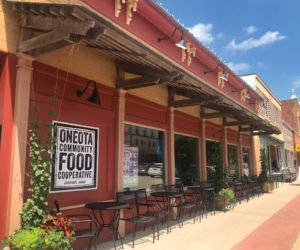There is a Season … For Fish
By: Kristin Evenrud, Grocery and Meat Buyer and Nate Fuler, Marketing and Outreach Manager
Our produce department does a great job of keeping as much variety in-stock as possible at any given time. Seasons vary throughout the world due to the difference in hemispherical location. It is fairly common knowledge that the strawberries we are getting are not grown anywhere close to Iowa in January. But, have you stopped to think about the seasonality of fish?
Let’s look at salmon in particular. The commercial Alaskan salmon season runs primarily May-September with different types of salmon (Pink, Coho or Silver, Keta, Sockeye or Red, Chinook, King, and Sake) running throughout the season. My personal favorites, based on flavor and price, happen to be Coho and Sockeye. During the spring and summer months when fish are “running” in abundance, I tend to eat as much fresh fish as I can. But in the winter, when the salmon are not running, flash-frozen salmon is a much more sustainable option – and just as delicious.
You aren’t allowed to turn up your nose to frozen salmon until you experience what we have at the Co-op. We’ll tell you how to cook it in a minute. First, however, we’ll treat you to the story behind the fish.
The salmon that we carry in the freezer, and fresh when in season, is from the Loki Fish Company based out of West Seattle, WA. Loki was founded by Pete Knutsen and Hing Lau Ng in 1979 when boat fishing Southeast Alaska (Ketchikan) and Puget Sound. Flash forward to 2014. The company now has two boats of their own, as well as two more they contract with, and their children have joined the business with them. Older son Jonah captains the original boat named the Loki, while younger son Dylan manages the business.
Their family is personally involved in every step, from harvest to processing and direct sales. This ensures their high quality standards are adhered to every step of the way. They harvest the salmon with care and concern, while also being internationally certified by the Marine Stewardship Council. Their practice of immediately chilling the fish to below freezing – while still on the boat – ensure the optimal taste is secured for the consumer.
Loki participates in local farmers markets in the Seattle area and can be found on food co-op shelves throughout the United States. Some photos of their operation and farmers market stands can be found with this article.
As you can imagine, the Knutsens are acutely aware of the concern about radiation in seafood due to the recent Fukishima incident in Japan. They recently conducted independent testing for radiation on the five different species of fish they catch. These tests came back clean as a whistle and show that Alaskan Salmon are safe to consume.
You might say, “Well, that’s salmon, what about the other fish?” In response, I have to say the discussion amounts to a whole other can of worms. Factors such as farmed versus wild-caught, country of origin, and how the fish were caught all come into play. Not to mention that it is imperative to stay on top of where a particular larger supplier is sourcing a kind of fish on the day you talk to them to place your order.
When researching the types of fish to carry at the Co-op, we enlist the knowledge of entities such as the Monterey Bay Aquarium Seafood Watch, Marine Stewardship Council, Environmental Defense Fund’s Seafood Selector, and Marine Conservation Society – two of which (Monterey Bay and Marine Conservation Society) currently have smartphone apps for easy use by consumers. We remain as diligent as possible in our sourcing in order to bring you what we consider to be the safest, most sustainable, flavorful and cost effective fish on the market.
Make sure to try the frozen salmon from Loki, and fresh when in season. To help you out, we recommend these great recipes when serving up salmon for two or for twenty, on the grill, in the oven, or on the stove. You will be pleasantly surprised how wonderful frozen fish can be.
Methods and Gear used to Catch Seafood.
Bottom Trawl – Drags a net and gear across the ocean floor, lots of bycatch and damage to the ecosystem.
Dredge – Drags a large metal basket across the ocean floor primarily to catch scallops, oysters, and clams, lots of bycatch and damage to the ecosystem.
Gillnetting – Large curtains of net are hung suspended by floats and weights, fish swim in and get stuck. The desired catch is sardines, salmon and cod but often also entangle shark and sea turtles.
Harpooning – A tradition method for large fish still used today by skilled fisherman. Bluefin Tuna and swordfish may be caught by this method, bycatch is not an issue.
Jig – This is another way to hand-catch fish. Usually used at night with a light to attract the fish, a grappling hook is used to snag the fish. This is considered an environmentally friendly method with low bycatch.
Longlining – Employs a central fishing line strung with smaller lines of bait. When used at the surface for tuna and swordfish bycatch can be a problem, when the line is sunk to the floor for halibut and cod bycatch is much less of a problem.
Midwater Trawl – A very large net is used to catch entire schools of fish at one time, using streamers to scare away seabirds and other species of fish – bycatch becomes less of a problem. The trawl also is kept above the ocean floor and has little to no impact on the environment.
Pole/Troll – Poles and line are used to target a variety of fish like tuna, mahi-mahi, and cod. This method creates low bycatch since fish are caught one by one.
Purse Seining – A wall of netting is drawn up around a school of fish. This can inadvertently result in bycatch and is sometimes used to catch pods of dolphins.
Seine Net – A small-meshed net suspended vertically in the ocean and is dragged over the soft floor in shallow water by hand. It can also be a bigger net powered by vessels.
Traps and Pots – Cages that are dropped to the ocean bottom to catch lobsters, crabs, shrimp, sablefish and Pacific cod. Generally there is less bycatch and seafloor impact than with mobile gear like trawls.
Trolling – A hook and line method of fishing tow lines behind or alongside a boat. Intended catch may be salmon, mahi mahi and albacore tuna. This selective method results in very low bycatch.
Most seafood in the U.S. is caught using nets dragged behind boats, such as purse seines, trawls and dredges (National Marine Fisheries Service, 2009).
KRISTIN’S FAVORITE SUPER-SIMPLE SALMON RECIPE
Drizzle fish with olive oil and sprinkle with salt and pepper. Place on parchment paper and bake at 350 degrees for 10-15 minutes. Or grill starting skin side down and flip it at halfway mark if you want the grill marks.
SLOW COOKED SALMON + MEYER LEMON RELISH
yummysupper.com – serves 4
Both of these wonderful recipes come from Alice Waters’ Chez Panisse Cookbook. An extremely low oven along with gentle moisture (provided by a little pan of water at the bottom of the oven) makes for the most tender and succulent fish imaginable! The heavenly Meyer lemon relish is fresh, tangy, and slightly sweet thanks to the the natural sugars in Meyer lemons. I think the relish would be great with all sorts of seafood and its bright flavors make it a perfect companion to the buttery rich slow cooked salmon.
SALMON:
1 center cut salmon fillet (1.25-1.5 pounds)
olive oil
sea salt
freshly ground black pepper
MEYER LEMON RELISH:
1 large shallot, minced
1 tablespoon white wine vinegar or lemon juice
sea salt
1 large Meyer lemon
1/4 cup olive oil (the original recipe calls for 1/2 cup, but 1/4 cup seemed like more than enough to me)
2 tablespoons chopped parsley
freshly ground black pepper
Preheat your oven to 200 degrees. Place a baking dish filled half way with water on the lowest rack of your oven, making for a nice moist environment for the salmon to cook.
Lay the intact salmon fillet on a lightly oiled baking sheet. Brush the salmon with a little more olive oil. Salt generously and sprinkle with freshly ground black pepper. Transfer salmon to the warm oven. It should take between 45 minutes to 1 hour for the salmon to cook, depending on the size and thickness of your fillet. You can tell the salmon is done when the fish feels just firm to the touch and the juices are starting to break through the surface. Alice says you can serve the salmon right away or let it rest for up to 3 hours before serving. (Doesn’t that sound helpful for a dinner party you want to prep in advance?)
While the salmon is cooking, make your Meyer lemon relish: first, in a small bowl, macerate shallot for 10-15 minutes in vinegar or lemon juice and a pinch of sea salt. Next, (leaving the skin on) cut lemon into 8 wedges. Remove seeds and cut out the core. Cut wedges in half again and slice very thin. Add the slivers of lemon to the macerated shallots. Add olive oil, parsley and season with sea salt and freshly ground black pepper to taste.
When you’re ready to eat, use your hands to break the salmon into chunks and serve with the Meyer lemon relish.
BASIC BAKED BREADED SALMON
By Kate Ramos
Difficulty: Easy | Total Time: 25 mins | Makes: 4 servings
An assertive fish like salmon can handle mustard’s bold flavor. Top the fish with parsley for freshness and breadcrumbs for crunch. For a fast, healthy dinner, we suggest serving it with a shaved vegetable salad.
What to buy: Panko is coarse Japanese-style breadcrumbs. It’s available in the international section of most supermarkets.
INGREDIENTS
2 teaspoons olive oil, plus more for coating the foil
4 teaspoons Dijon mustard
1 tablespoon finely chopped fresh parsley
1 (20-ounce) skin-on salmon fillet (1 1/4 pounds)
Kosher salt
Freshly ground black pepper
3 tablespoons panko
INSTRUCTIONS
Heat the oven to 425°F and arrange a rack in the middle. Line a baking sheet with aluminum foil and coat an area about the size of the fish with olive oil; set aside.
Place the measured oil, mustard, and parsley in a small bowl and whisk to combine. Lay the salmon on the foil, skin side down, and season it generously with salt and pepper. Evenly spread the mustard mixture all over the top. Sprinkle the breadcrumbs over the mustard mixture until it’s completely covered, then gently pat to get the panko to adhere.
Bake the fish for 12 to 15 minutes, then check for doneness. The center should spring back to the touch and the breadcrumbs should be golden brown. If it’s not ready, return the fish to the oven for a few minutes more. If the fish is ready but the breadcrumbs aren’t browned, broil about 2 minutes more or until golden brown.
http://www.chow.com/recipes/29341-basic-baked-breaded-salmon



